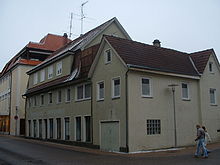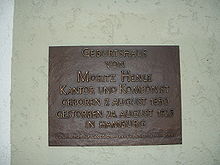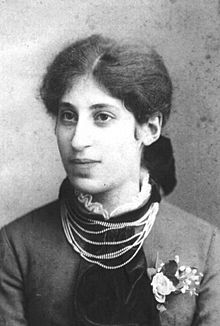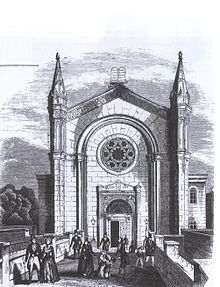- Moritz Henle
-
Birthplace of Moritz Henle in Laupheim
 Commemorative plaque in Laupheim
Commemorative plaque in Laupheim
Moritz Henle (7 August 1850 – 24 August 1925) was a prominent German composer of liturgical music and cantor of the Jewish reform movement.
Henle was born in the Upper Swabian town of Laupheim at a time when Laupheim had the largest Jewish community in the Kingdom of Württemberg. He was the seventh of eleven children. The family of his mother Klara Adler had been residents of Laupheim since the 18th century. In 1847 she married Elkan Henle, who had come to Laupheim from Ichenhausen. Elkan Henle was a highly respected master glazier who designed and executed the new Protestant prayer room at Großlaupheim Castle in 1847. Remaining evidence of Elkan Henle's artistic interest is the portal of the Jewish cemetery in Laupheim, which was designed by him.
From an early age, Henle showed a talent for music. He was a member of the boys choir at the synagogue in Laupheim. He was interested in learning to play the violin and the piano and was encouraged by his parents in these efforts. Due to initial financial help from Simon Heinrich Steiner, one of the co-founders of Hopsteiner, Moritz Henle was able to join the conservatoire at Stuttgart, where he attended lessons in piano, violin and singing. However, after two years Henle had to leave the conservatoire since his parents were unable to afford to pay the tuition fee any longer. He was forced to take up a career in a more secure profession, namely teaching. In 1864 Henle went to teacher training college in Esslingen, where he received, among other more secular subjects, training as a teacher for religious education. Due to regulations imposed in accordance with the supreme Jewish authorities within the Kingdom of Württemberg, Jewish teachers were obliged to be also trained as cantors, since they were only supposed to be teaching Jewish children,
After finishing teacher training in 1868, Henle started his first job as teacher and cantor in Laupheim, where he also gave music lessons at the Jewish elementary school, and contributed to services at the synagogue during Shabbats and holidays. He was the director of the Jewish choral society Frohsinn ("Cheerfulness") and founded a mixed choir for the synagogue and took part in public concerts. After the end of the Franco-Prussian War in 1871 the city council commissioned the only 21-year-old Moritz Henle to compose a peace hymn which was performed by the city's three male choirs, a sign how highly his musical talent was already esteemed.
In 1873 Henle went to Ulm to become hazzan at the newly built synagogue there. As there was no Jewish elementary school in Ulm, Henle was able to concentrate on religious service, directing the choir as well as religious and music education. He was also able to resume his studies, albeit part-time, at the conservatoire in Stuttgart, where he enrolled in composition and singing classes. In 1877 he passed his second professional exam in order to be a fully qualified teacher and one year later he also passed the higher cantor examinations.
His talent and reputation had come to the attention of rabbi Max Sänger from Hamburg and was invited, in 1879, to perform at the reform synagogue, Hamburg Temple, in Hamburg with the prospect of getting a permanent tenure there. He was also asked to perform in Königsberg, East-Prussia, but left the position as cantor to his friend Eduard Birnbaum, and decided to accept the offer from Hamburg. He immediately began his work in Hamburg by forming a mixed choir. One member of the mixed choir was Caroline Franziska Herschel who was related to Moses Mendelssohn. They married in 1882 and from that date on his wife accompanied Henle during his performances as well as during official functions. They had three children, Alwin, Paul Wiliam and Albertine.
It is remarkable that Henle composed mostly for mixed choirs accompanied by an organ. Both were considered to be revolutionary at the time, given the traditionally strict separation of men and women in the synagogue. During the 34 years as main cantor in Hamburg, Henle showed his talents in various fields. Apart from composing, he worked as an author, developed the choirs of the reform synagogue, trained future singers and cantors, and was chairman of the German Association of Cantors for more than 15 years.
Henle reintroduced biblical cantillation and Ashkenazi pronunciation at the Hamburg synagogue. Until then the cantors of the Hamburg synagogue had used Sephardic recitative and Portuguese pronunciation of Hebrew.
The tension between these traditions and the growing reformist movement within the congregation subsequently increased. Following the ideas of the reform movement, Henle introduced new concepts by composing several songs in which he, as in his recitative, employed traditions of his Southern German birthplace. His compositions were also influenced by the works of Felix Mendelssohn-Bartholdy, who also had a profound effect on Henle's contemporaries. He was also heavily influenced by the works of Viennese cantor and composer Salomon Sulzer.
His efforts in reforming the musical part of the liturgy in Hamburg were ultimately successful and his mixed choir became famous for its performances which also benefited the fortunes of the synagogue.
At the time Henle's compositions were highly regarded and used not only by reform congregations in Germany but also in the United States. Many of Henle's compositions were printed and published, for instance, in 1900 Kompositionen von M. Henle with 30 different hymns and in 1913 a Haggadah for the Passover celebration at home with compositions by Henle and Jacques Offenbach.
Henle died in Hamburg in 1925. His wife Caroline perished in Theresienstadt concentration camp in 1943.
In his birthplace, Laupheim, a street was named after Moritz Henle.
See also
References
- Sendrey, Alfred. Bibliography of Jewish music, Columbia University Press, 1951.
- Wininger, Salomon. Große jüdische National-Biographie, vol. 3, Orient, 1928.
Categories:- 1850 births
- 1925 deaths
- German Jews
- People from Laupheim
- People from the Kingdom of Württemberg
- Reform Judaism
- Hazzans
- Jewish music
- Jewish German history
Wikimedia Foundation. 2010.





